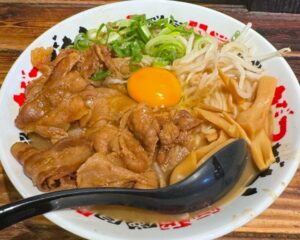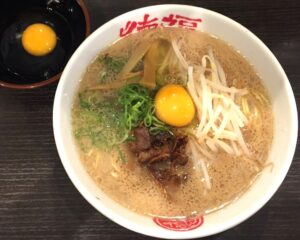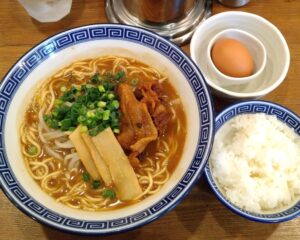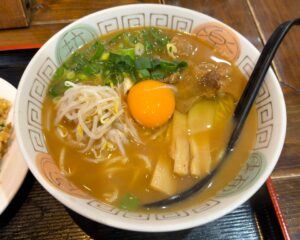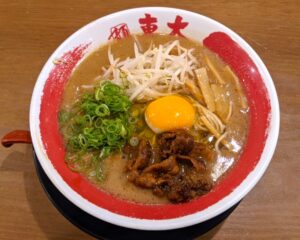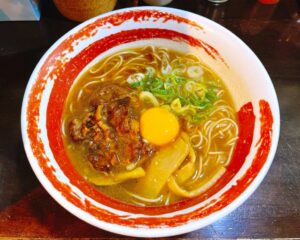Tokushima Ramen (Tokushima Pref.)
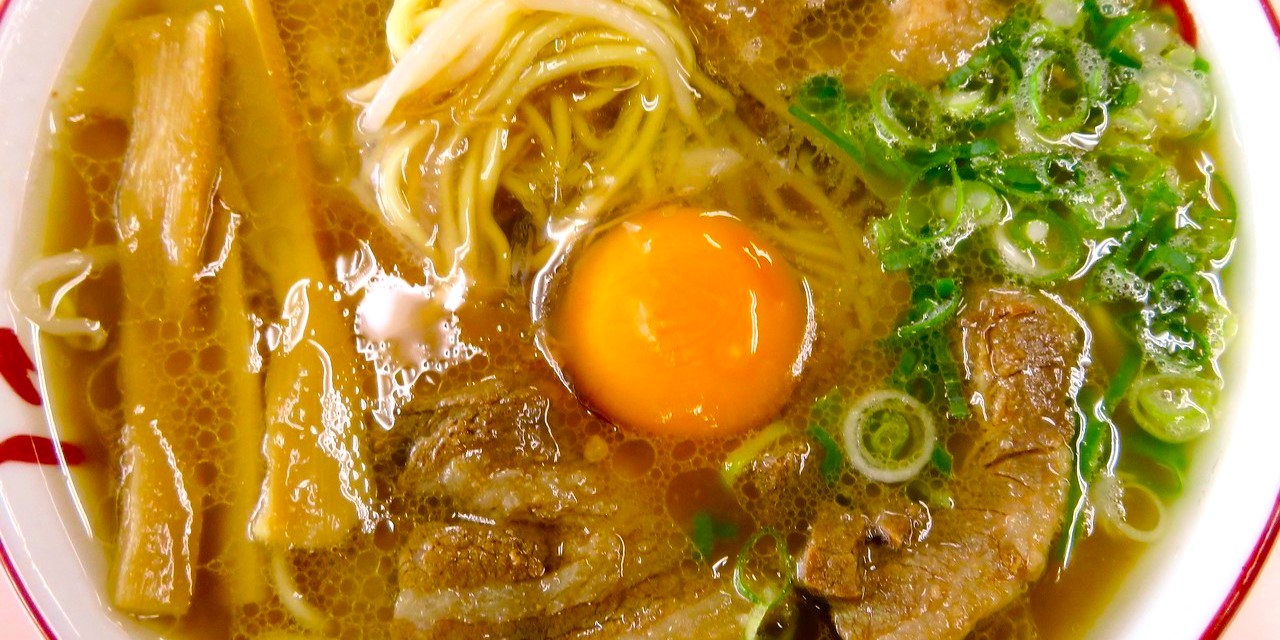
What is Tokushima Ramen(徳島ラーメン)?
This is a local ramen from Tokushima Prefecture. It is characterized by soups that can be divided into three main types: white, brown, and yellow, and toppings such as meat (pork belly) and raw eggs. It is also recognized as sukiyaki-style ramen. Because there was a factory for Tokushima Ham, the predecessor of Nippon Ham, pork bones were available at a low price, and ramen based on pork bones was created.
Naruto type(鳴門系), Tokushima type(徳島系), Komatsushima type(小松島系)
Although it has a history of nearly half a century, the name “Tokushima Ramen(徳島ラーメン)” was not well known. In 1998, “Inotani(いのたに)” was introduced to the Shin-Yokohama Ramen Museum, and its name gained attention, and it began to be introduced in the media a lot. The local town magazine “Awawa(あわわ)” seems to be particularly active.
Tokushima ramen has three types of soup. A yellow soup centered around Naruto(鳴門). A brown soup made mainly in Tokushima(徳島). And the cloudy white soup from the Komatsushima(小松島) area.
“Inotani(いのたに)” is a brown soup from Tokushima, so many of the soups that were introduced were of this type.
●Sweet and spicy soup based on pork bones.
●The noodles are short so that they are easy to slurp.
●The most distinctive feature is the pork belly simmered in a rich sauce instead of chashu. This is why it is called sukiyaki-style ramen, including the soup.
●Furthermore, the egg topping is not a boiled egg but a raw egg. Does this also apply to sukiyaki?
The main characteristic of Tokushima is the raw egg and stewed pork belly, ingredients that are rarely seen elsewhere.
The representative Tokushima-style (brown soup) shops are “Inotani(いのたに)” and “Kanton(広東).” The former gained national recognition after entering the Shin-Yokohama Ramen Museum. Homemade noodles blend well with the unique characteristics of Tokushima ramen. “Kanton” is not a Chinese restaurant, but a proper ramen shop. This shop is also said to have started the sukiyaki-style ramen style.
Founded almost the same as Inotani (1966/currently closed).
There is also a long-established shop called “Yoake(よあけ),” which is slightly different from Tokushima ramen. It is characterized by a light and neutral soup (yellow color). “Tosa(土佐)” is known for its rich and rich backfat soup, and the old interior of the shop is also worth seeing. Recently, “Furuya(古家)” has become popular as part of the new wave. The owner, who was an engineer, inherited the taste of Tokushima while demonstrating his uniqueness (closed).
The representative Naruto type (yellow soup) is “Sanpa(三八)” from Naruto. A slightly sweet soup that looks slightly yellow due to the addition of light soy sauce based on pork bones and chicken bones. After training here, Yushou(友翔) became independent in Osaka.
It perfectly recreated the taste of “Sanpa(三八)” and became a popular shop in Kansai (closed in 2014).
The representative of the Komatsushima type (cloudy white soup) is “Okamoto(岡本)”. There is a theory that this Komatsushima style (started at food stalls around 1949) is the origin of Tokushima ramen.
It is said that the reason why tonkotsu ramen spread to Tokushima was because there was a factory of “Tokushima Ham(徳島ハム)“, the predecessor of Nippon Ham(日本ハム), which supplied a large amount of cheap tonkotsu pork bones. However, due to the Tokushima ramen boom, new shops were opened one after another in Tokushima, and there was a shortage of pork bones.
So why was the Tokushima ham factory built in Tokushima in the first place? During World War I, a camp for German soldiers was established in Naruto (1914), and Japan allowed German prisoners of war as much freedom as possible. As interactions with the villagers progressed, the ham and other food processing techniques introduced at that time were passed on, and Tokushima Ham was established in 1942. Similarly, bread making techniques have been passed down and still exist today (Germany House, Naruto City). These episodes were also depicted in the 2006 film “Baltic Paradise” (starring Ken Matsudaira).
In Tokyo, “Udatsu Shokudo(うだつ食堂)” opened at the same time as the Tokushima ramen boom. BGM is Awa Odori tradistional dance music of Tokushima. Additionally, “Tokufuku(徳福)” opened in Yokohama. These were the only a few shops to be found in the Tokyo metropolitan area, and the Tokushima ramen boom began to subside.
Additionally, Tokushima ramen tends to expand and open its doors across the ocean to the big city of Osaka.
Ramen-Japan / Examples of Ramen Shops
Examples of the Tokushima ramen shops with [Tokushima style (brown soup)]
-
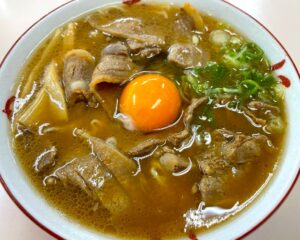
-
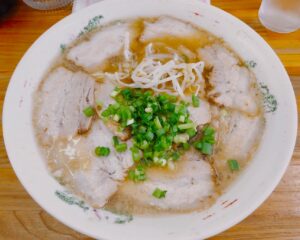
-
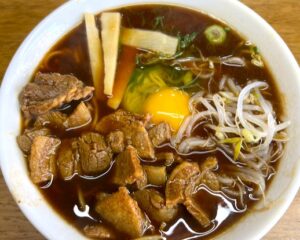
Myoudouken(名東軒) *Founded in 1971. A popular local shop located in a residential area.
-
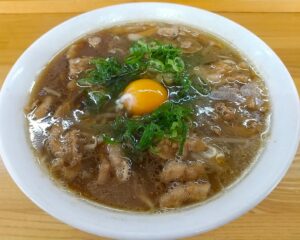
-
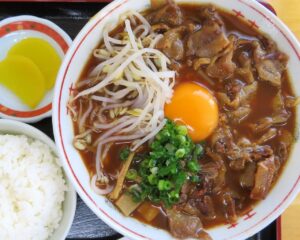
Chuka Soba Shunyoken(中華そば 春陽軒) *Reopening in April 2024.Popular famous ramen shop.
-
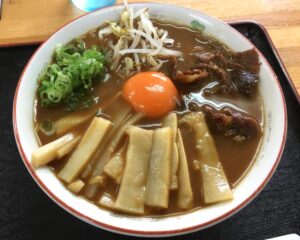
Chuka Soba Yamakyo(中華そば やまきょう) *Shunyoken series. “Yamakyo Red” is spicy.
-
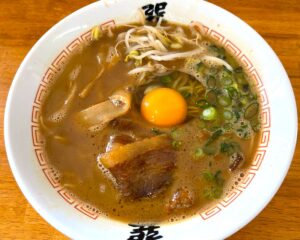
-
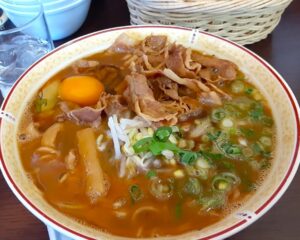
-
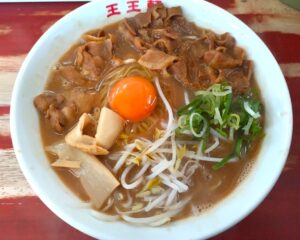
Shina Soba Wan Wan Ken(支那そば 王王軒本店) *Homemade noodles. A popular shop for its rich soup.
-
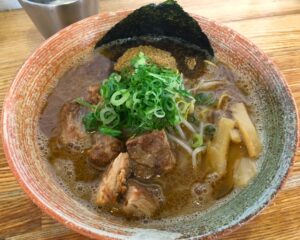
Chuka Soba Tamura(中華そば 田村) *A cafe-like shop. Limited time ramen is popular.
-
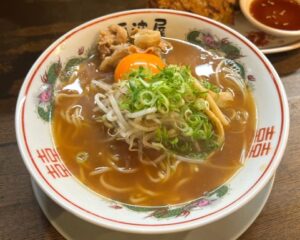
-
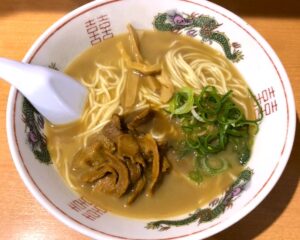
Examples of The Tokushima ramen shops with [Naruto style (yellow soup)]
-
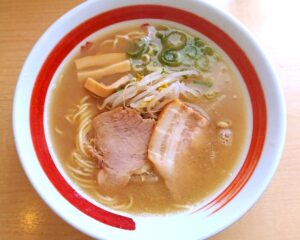
-
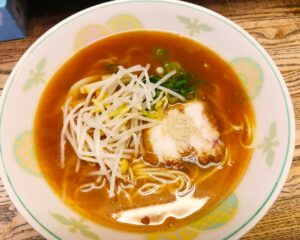
Hachimanya(八万屋) *Founded in 1949. Other than ramen, meat bun and shumai are also famous.
-
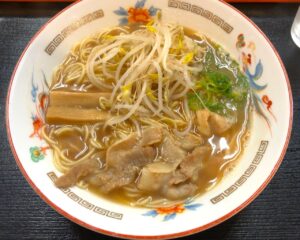
Shina Soba Yoake Ekimae Shop(支那そば よあけ駅前店) *Light soup without chemical seasonings.
-
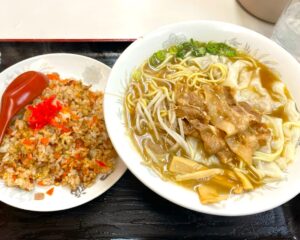
-
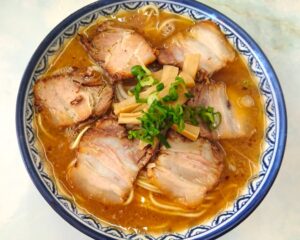
Chuka Soba Kawai(中華そば かわい) *Inheriting the taste of the famous shop Awaichi.
-

Chuka Soba Shop Rarai(中華そばショップ 来来) *An orthodox soy sauce tonkotsu ramen near Tokushima Station.
Examples of the Tokushima ramen shops with [Komatsushima type (cloudy soup)]
-
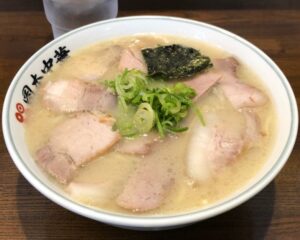
-
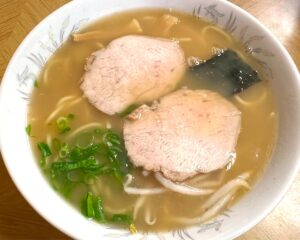
Matsumoto Chuka Soba Shop(松本中華そば店) *Representative of white Tokushima ramen, founded in 1957.
-
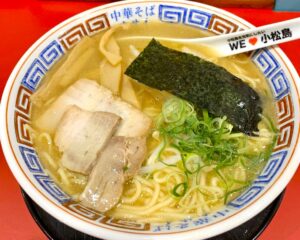
Chuka Soba Kasai(中華そば カサイ) *Reopened as the oldest shop that started as a food stall in 1946.

